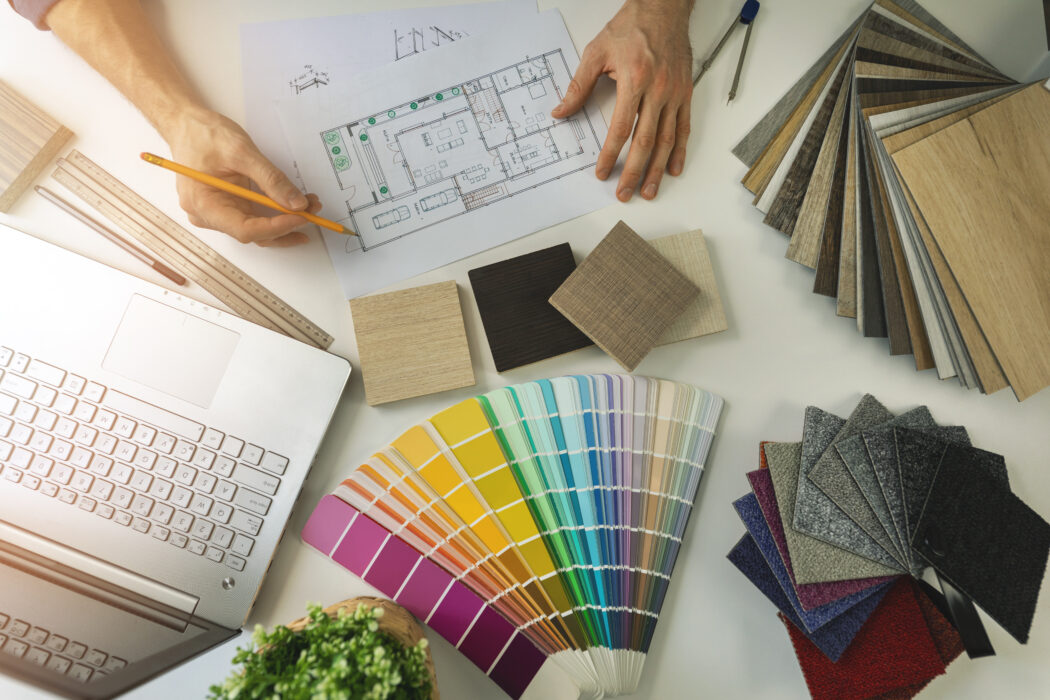Interior designers are professionals who design and decorate the interiors of buildings, homes, and other spaces. This field is closely related to the Artistic theme code in the Strong Interest Inventory Assessment, as interior designers use their creativity and artistic skills to create beautiful and functional spaces.
Interior designers must have a strong eye for color and proportion, as well as a good understanding of design principles such as balance, scale, and harmony. They must also be able to communicate their ideas effectively, both in writing and verbally, and to work well with others, as they often collaborate with architects and builders. They may also work with clients to determine their needs and preferences.
Working as an interior designer can be both challenging and rewarding. It requires strong attention to detail, as well as the ability to think creatively and to solve problems. It also requires a good understanding of materials, construction methods, and safety regulations, as well as the ability to manage budgets and schedules.

This article provides information about the Strong Interest Inventory Interior Designer career, including the median salary, tasks, career growth, and more.
Interior designers can specialize in a variety of areas. Some may specialize in residential design, creating beautiful and functional spaces for homes. Others may specialize in commercial design, designing offices, hotels, restaurants, and other public spaces.
Interior designers utilize a variety of technologies in their work. These technologies include computer-aided design (CAD) software, 3D visualization programs, and even virtual reality (VR). CAD software allows designers to create precise plans and drawings for a space. 3D visualization programs enable designers to quickly create three-dimensional renderings of the space, allowing them to visualize how the space will look and feel. Finally, virtual reality allows designers to give clients a realistic tour of space, allowing them to make changes and adjustments as they see fit. Interior designers may use product databases and online catalogs to research materials, such as flooring, lighting, and furnishings, and to compare prices and options.
Education-wise, a minimum of a bachelor’s degree in interior design is typically required, or a related field such as architecture or fine arts. Some states also require interior designers to be licensed, and this may involve passing an exam and meeting certain educational and experience requirements.
In addition to formal education, many interior designers also acquire certification from a professional organization, such as the National Council for Interior Design Qualification (NCIDQ) or the Interior Design Society (IDS). These certifications demonstrate a commitment to the field and a high level of expertise and can be an advantage when seeking employment.
In some cases, interior designers may also be required to complete continuing education programs to maintain their certification. This may involve attending workshops, conferences, or online courses to stay up to date on the latest best practices and technologies in the field.
Generally, Interior Designers earn an average salary of $51,000 per year. However, salaries can be higher or lower depending on the size of the project, the complexities of the job, and the client’s budget. Experienced and/or specialized Interior Designers may earn more than the average salary. For example, interior designers working in specific industries like architecture and engineering services, and interior design services may earn higher salaries. Some interior designers who work for large design firms or corporations, or are self-employed, may also have the potential to earn higher salaries.
Below are some employment trends for Interior Designers:
- Median Salary: $29.01 hourly, $60,340 annually
- Employment: 93,300 employees
- Projected growth (2021-2031): Little or no change
- Projected job openings (2021-2031): 8,200
Visit Our Myers-Briggs Type Indicator® Career Resource Database for Information on MBTI® Personality Type Careers
To Learn More About the Myers-Briggs Type Indicator, visit our About MBTI Test Page
Visit Our Validity and Reliability Factual Strong Interest Inventory® Page
Gain access to your best-fit careers, occupational preferences and interests with these career based Strong Interest Inventory® Assessments:
-
Strong Interest Inventory® & Skills Confidence Profile + Strong Interpretive Report
Price: $72.95 Buy NowDIGITAL DELIVERY
- Better understand your strengths, interests, preferences, and areas of confidence
- Connect your innate traits to a successful and satisfying career
- Links to complete assessments are sent digitally via email within 2-3 business hours of purchase
- Results sent in PDF form via email within 6-8 business hours
Download sample Strong Interest Inventory® & Skills Confidence Profile + Strong Interpretive Report
-
Strong Interest Inventory® Interpretive Report
Price: $64.95 Buy NowDIGITAL DELIVERY
- This report starts with the same foundation as the Strong Interest Inventory Profile but goes even further into analyzing your likes and dislikes and how that can help you lead a more fulfilling, satisfied life
- Dive deeper into what your interests, hobbies, favorite topics, and vocations could mean for your career and personal life
- Links to complete assessments are sent digitally via email within 2-3 business hours of purchase
- Results sent in PDF form via email within 6-8 business hours
Download sample Strong Interest Inventory® Interpretive Report
-
MBTI® Career Report + Strong & MBTI Combined Career Report + Strong Profile
Price: $96.95 Buy NowDIGITAL DELIVERY
- Three of the top career-focused tests included
- Designed to uncover the best career fit for your true self
- Links to complete assessments are sent digitally via email within 2-3 business hours of purchase
- Results sent in PDF form via email within 6-8 business hours
Download Sample MBTI® Career Report
Download Sample Strong & MBTI® Combined Career Report Plus Strong Profile
Download Sample Strong Interest Inventory® Profile Report
-
Strong Interest Inventory® Profile
Price: $54.95 Buy NowDIGITAL DELIVERY
- Set yourself up for success by choosing a career that reflects your personal interests, preferences, likes, and dislikes
- This test compares your preferences against professionals actively in specified industries, rather than basing results on theory alone
- Links to complete assessments are sent digitally via email within 2-3 business hours of purchase
- Results sent in PDF form via email within 6-8 business hours
-
iStartStrong™ Report
Price: $39.95 Buy NowDIGITAL DELIVERY
- Plan your future career based on your interests and passion
- Start on the right path to finding a career that you’ll enjoy for years to come
- Links to complete assessments are sent digitally via email within 2-3 business hours of purchase
- You will be able to self-download your report as a PDF document immediately following the completion of your assessment.
Explore our Strong Interest Inventory® Blog Pages:
- Strong Interest Inventory Realistic Theme Explained
- Strong Interest Inventory Artistic Theme Explained
- Strong Interest Inventory Investigative Theme Explained
- Strong Interest Inventory Social Theme Explained
- Strong Interest Inventory Enterprising Theme Explained
- Strong Interest Inventory Conventional Theme Explained
Assessment Categories
References
- Bureau of Labor Statistics wage data and 2012-2022 employment projections Onetonline.org














